Como cuidar de um gato
Você já deve ter ouvido falar que os gatos têm nove vidas. Bem, talvez isso seja verdade, mas uma coisa é certa:seu gato pode ter uma vida longa e saudável com os devidos cuidados. Há muitas coisas a considerar ao cuidar de um gato, e vamos cobri-las todas nas seções a seguir:
Como escolher um gato
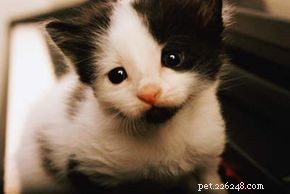
Antes de realmente ter um gato, descubra que tipo de gato você quer:gatinho ou gato adulto; pêlo comprido ou pêlo curto; gato de raça pura ou beco; macho ou fêmea; malhado, remendado ou de cor sólida.
Se você quer um determinado tamanho, idade, sexo, raça ou aparência de gato, faça uma pesquisa extra antes de sair para encontrar um. Você pode se surpreender ao descobrir que a aparência que você ama não se encaixa bem com seu estilo de vida. Por exemplo, se você gosta de uma casa tranquila, um siamês pode não ser o gato para você:eles são notórios "faladores". Da mesma forma, um persa é lindo de se ver, mas a menos que você se comprometa a se cuidar quase diariamente (ou pagar um profissional para fazer isso a cada semana), um bom gato de pelo curto pode ser uma ideia melhor. Você viaja muito? Então você precisa de um gato mais maduro – com pelo menos oito meses de idade ou mais. Dois gatos são melhores ainda para que possam fazer companhia um ao outro enquanto você estiver fora.
Gato ou gatinho?
Todo mundo adora gatinhos. Eles são fofos, engraçados e fofinhos - não há dúvida sobre isso. Mas não cometa o erro de que eles são "bebês". Quando um gatinho está pronto para ficar longe de sua mãe e morar em sua casa, ele pode andar, correr, pular e escalar como o equivalente felino de uma criança de dez anos. Além do mais, se você pegar um gatinho hoje, em apenas alguns meses você terá um gato adulto - um gato que viverá em média de 12 a 15 anos.
Se você tiver tempo, ambiente e energia para criar um gatinho, faça isso - é uma experiência maravilhosa. Basta lembrar que os gatinhos são de alta manutenção. Eles exigem muita atenção. Eles precisam de cuidados veterinários de rotina que consistem em doses de reforço, vermifugação e esterilização ou castração. Quase todos os gatinhos jovens começam afetuosos e passivos, mas precisam de alguma socialização e treinamento para permanecerem assim; e mesmo assim, você não saberá como será a personalidade adulta deles até que eles cresçam.
Finalmente, crianças muito pequenas e gatinhos muito jovens geralmente não se misturam bem. É bom pensar que uma criança e um gatinho de dez semanas podem "crescer juntos", mas não é assim que acontece. Em seis meses, aquela bolinha de pelo que seu filho poderia carregar terá crescido em mais de cinco quilos de um gato adulto, e seu filho de três anos terá... três anos e meio!
Encontrando o gato certo
Certamente não há perigo de escassez de gatos nestes Estados Unidos - há muitos gatos por aí e mais alguns. Na maior parte do país, você poderia simplesmente abrir a porta da frente ao nascer do sol, e um gato provavelmente entraria antes de você terminar o café da manhã.
Na verdade, o número de gatos ao redor coloca você em um dilema. Como você escolhe o certo? Será saudável? E quanto aos problemas ocultos de saúde ou comportamento? O que acontece com o gato se as coisas não derem certo em sua casa?
Ter um gato não é como comprar um cortador de grama ou um secador de cabelo; eles não vêm com garantias. Cada um será diferente, o que significa que alegrias e problemas únicos vêm com cada gato. Ainda assim, fontes para gatos devem ajudá-lo a tomar uma decisão. Embora a fonte não possa prometer que o gato nunca ficará doente, eles podem tomar medidas para dar ao gato as melhores chances possíveis de ficar bem. Boas fontes para encontrar o gato certo para você incluem:
Amigos e vizinhos. As chances são de que alguém que você conhece tenha um gato ou gatinhos precisando de um lar. Muitas vezes, pegar um gato de um vizinho ou amigo funciona melhor para todos, especialmente se for um gatinho da ninhada do seu vizinho ou o animal de estimação da família de um amigo alérgico. Seu relacionamento pessoal com essa fonte geralmente significa que você também obterá a história direta sobre esse gato em particular. No entanto, alguns avisos sobre obter seu gato de um amigo ou vizinho:não espere que o gato tenha os cuidados veterinários extensos que um gato de um abrigo ou criador tem e tenha cuidado ao misturar negócios e amizade.

Abrigos de animais. Milhões de gatos desabrigados acabam sendo sacrificados em abrigos de animais todos os anos. Adotar de um abrigo salva uma vida, abre espaço para outro gato e é uma maneira barata de obter um animal de estimação com vacinas e castração de baixo custo. Esteja preparado para passar por inscrições e entrevistas, algumas das quais podem parecer um pouco pessoais e insistentes. Não leve para o lado pessoal - eles têm boas razões para isso. Além disso, certifique-se de verificar as instalações e as condições dos animais de estimação adotáveis. Como os animais vivem em companhia próxima, doenças, vermes e pulgas podem ser um problema. Pet Finders (www.petfinder.org) mantém um banco de dados de gatos disponíveis para adoção em abrigos locais.
Criadores. Se você quer um gato de raça pura, este é o caminho a percorrer. Bons criadores são extremamente bem informados sobre gatos em geral e sua raça em particular e são cuidadosos com quem vendem seus gatos. Cuidado com os puros-sangues “de pechincha” e os “criadores de porão” (pessoas que se reproduzem estritamente por lucro). Um criador respeitável está interessado em manter um animal de alta qualidade, mantém registros cuidadosos e geralmente produz apenas uma ou duas ninhadas por fêmea reprodutora por ano. Peça uma referência de criador de associações nacionais de raças, como a Cat Fanciers' Association (www.cfa.org).
Gatos vadios. Às vezes você nem precisa se preocupar em encontrar o gato certo, o gato certo encontra você. Muitas pessoas juram que estes são os melhores gatos para se ter. Não há entrevistas de adoção ou taxas quando você recebe um cachorro de rua, e é mais do que provável que você esteja salvando uma vida. Por outro lado, você terá que cobrir o custo de injeções, vermifugação, castração e afins. Muitos cães de rua têm outros problemas de saúde que podem não aparecer imediatamente e podem ser caros para tratar. Às vezes, as sociedades humanitárias locais ajudam com os cuidados veterinários iniciais, ou um hospital de animais da área pode oferecer taxas reduzidas para o tratamento de um gato enjeitado, mas não conte com isso.
Outra decisão importante que você precisa tomar ao escolher um gato é se você terá ou não um gato de interior ou de exterior. Saiba mais sobre as ramificações de cada decisão na próxima seção.
Escolhendo um gato interno versus um gato externo
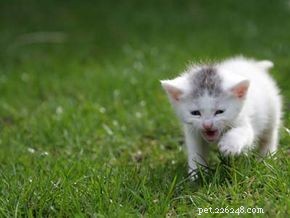
Talvez nada seja tão lamentável quanto o lamento de um gato que quer estar do outro lado de uma porta. Quando é a porta da frente, muitos de nós entendemos que nossos gatos não serão verdadeiramente felizes a menos que saiam. Mas, novamente, a maioria dos gatos faz o mesmo tipo de barulho quando quer entrar (ou, aliás, quando quer passar por qualquer porta). Os gatos realmente querem sair de casa? Eles precisam? E mesmo que a resposta para ambas as perguntas seja "sim", isso é realmente do interesse deles?
Os gatos precisam sair como os cães?
A principal razão pela qual os cães são levados para passear é a eliminação, seguida de perto pelo exercício. Apenas os cães mais pequenos conseguem correr o suficiente dentro de casa. Os cães são caçadores de matilha, o que significa que trabalham cooperativamente para levar sua presa até a exaustão. Isso pode levar o dia todo, o que significa que os cães têm um instinto natural de correr... e correr... e correr. Você precisa de muito espaço aberto para esse tipo de trabalho. Os gatos, por outro lado, são "caçadores de emboscadas". Eles contam com rajadas relativamente curtas de corrida muito rápida. Um corredor de qualquer comprimento decente oferece muito espaço para isso. Isso combinado com o instinto de enterrar os dejetos (e é por isso que os gatos usam uma caixa de areia) não é uma razão premente para levar um gato ao ar livre.
É natural um gato sair de casa
Claro, ar fresco e sol são bons para qualquer um - humano ou gato. Mas a vida ao ar livre é realmente mais "natural" para o seu gato? Claro, seus ancestrais selvagens viviam ao ar livre. Mas isso foi há alguns milhares de anos e várias centenas de gerações atrás. Para completar, esses ancestrais viviam nas regiões áridas do Oriente Médio – muito longe do clima e dos arredores dos Estados Unidos hoje. Uma vez que os gatos foram domesticados, eles deixaram de ser completamente "naturais"; uma vez que foram arrancados de seu habitat original, eles tiveram que fazer o possível para adaptar os instintos afiados ao longo de dezenas de milhares de anos de vida nos desertos do Oriente Médio às suas novas circunstâncias. Algumas dessas circunstâncias – o frio intenso de um inverno no meio-oeste, cães e animais selvagens que os transformarão de caçadores em caçados, e carros e caminhões em alta velocidade, só para citar alguns – eles nunca podem se adaptar.
As atividades ao ar livre não tão boas
O que está esperando pelo seu gato do lado de fora da sua porta da frente? Sim, há árvores e grama e todas as vistas, sons, cheiros e alegrias da natureza - coisas boas para todos nós saborearmos. Mas também existem animais cruéis, pessoas cruéis, agentes de trânsito, doenças e controle de animais (que podem estar dentro do direito legal de agarrar e apreender seu gato, se ele sair de sua propriedade). A única maneira confiável de manter seu gato a salvo de todos esses perigos mortais é mantê-lo dentro de casa.
Verdade seja dita, os gatos do campo não são necessariamente mais seguros ao ar livre do que os gatos da cidade. Claro, há muito mais chance de ser atropelado por um carro ou atacado por um cachorro de rua na cidade. Mas no campo, temos alguns predadores que correm maiores, mais rápidos e mais espertos do que um cão selvagem da cidade. Também temos menos luz nas estradas, tornando os animais de rua mais difíceis de ver - e mais fáceis de atingir - e geralmente mais tipos de insetos portadores de doenças, como carrapatos.
Uma série de doenças felinas graves e fatais precisam de contato com gatos infectados - ou áreas onde os gatos infectados frequentam muito - para se espalhar. O vírus da imunodeficiência felina (FIV), que causa um colapso no sistema imunológico de combate à doença do gato, é transmitido principalmente por mordidas de gatos infectados. E o vírus da leucemia felina (FeLV) geralmente requer contato próximo prolongado com um gato infectado, como compartilhar caixas de areia ou tigelas de comida e água, ou cuidados mútuos. Repetidamente, os riscos de doença são menores ou insignificantes para gatos de interior, significativamente maiores para gatos de exterior ou interior/exterior. Os donos de gatos - especialmente aqueles com crianças pequenas - devem estar particularmente cientes de que os gatos ao ar livre são mais propensos a pegar doenças e parasitas que podem afetar os seres humanos, desde pequenos aborrecimentos como pulgas a doenças mais graves como a doença do carrapato de Lyme a condições extremamente perigosas como raiva.
Saindo com segurança
Só porque é mais seguro para o seu gato viver dentro de casa e não andar livremente, não significa que ele nunca possa ver a luz do dia, exceto pela janela. Uma trela e arnês (não uma coleira) é uma maneira bastante segura para você e seu gato tomarem ar fresco e sol. Andar na coleira é um gosto adquirido que alguns gatos nunca adquirirão. A experiência regular desde a infância ajuda, e alguns gatos treinados com coleira até solicitam uma caminhada. Claro, um gato na coleira ainda corre o risco de pegar pulgas – e de encontros com cães e gatos soltos na vizinhança.
Construir uma corrida de gatos não é tão difícil quanto parece. As passagens devem ser fechadas em todos os lados (incluindo o topo) e solidamente ancoradas e construídas. As telas devem ser do tipo mais pesado de malha externa e as paredes devem se estender alguns centímetros abaixo do solo para evitar que os gatos cavem para sair - ou outros animais cavem para entrar. com uma porta para animais de estimação ou outra porta para dentro de casa, certifique-se de que inclui algum tipo de abrigo aquecido e à prova d'água para o seu gato se refugiar em caso de mau tempo.
É especialmente importante que uma corrida ou outro recinto externo tenha um teto. Os gatos são ótimos escaladores e saltadores, e mesmo uma parede de 2,5 a 3 metros pode não segurá-los, especialmente se houver telas nas quais se prender. O teto e as paredes da pista também fornecem outro tipo de segurança – eles mantêm outras coisas do lado de fora. As aberturas no telhado ou nas paredes permitem que animais, pessoas e coisas hostis ou perigosos entrem em uma área da qual seu gato pode não conseguir escapar.
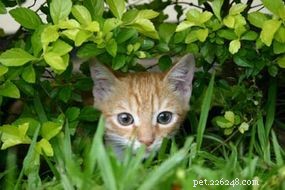
Gatos soltos entram em brigas altas e noturnas com outros gatos, mastigam ou desenterram plantas dos vizinhos, matam pássaros locais (mas também podem ajudar a controlar a população local de roedores) e enterram seus dejetos nos jardins de outras pessoas. Enquanto algumas pessoas – e alguns donos de gatos – veem isso como pequenos aborrecimentos, muitas outras pessoas os veem como problemas muito mais sérios. Se o seu gato entrar em uma briga, ele pode fazer mais do que acordar os vizinhos por causa dos uivos e gritos. Os arranhões superficiais que você pode ver no rosto ou nas costas não são tão ruins. Mas ele também pode ter feridas de mordida que se fecham rapidamente, selando a sujeira e os germes e criando um abscesso doloroso vários dias depois. As mordidas durante as brigas também parecem ser a principal forma de disseminação do vírus da imunodeficiência felina. Gatos inalterados que vagam livremente também contribuem para a superpopulação de animais de estimação, um problema que enche os abrigos de animais até a capacidade e além, resultando em milhões de cães e gatos sendo "colocados para dormir" todos os anos.
Agora que você escolheu o gato perfeito para você, é hora de aprender a cuidar dele. Começaremos na próxima seção com dicas para alimentar seu gato.
Dicas para alimentação de gatos

"Você é o que você come" é um sólido senso comum que é tão verdadeiro para o seu gato quanto para você. Alimente seu gato com uma dieta de qualidade, e é mais provável que você tenha um gato saudável.
A indústria de alimentos para animais de estimação é um grande negócio – e com razão. Existem bem mais de 100 milhões de cães e gatos vivendo em lares americanos, além de quem sabe quantos mais em abrigos, gatis e canis em todo o país. Para completar, você tem milhares de pessoas alimentando animais abandonados. Se você acha que um único gato pode consumir cerca de 90 libras ou mais de comida de gato em um ano, estamos falando de centenas de milhões de dólares gastos anualmente, apenas para alimentar o gatinho.
Assim como a comida humana, existem algumas guloseimas felinas saborosas que são boas para gatos e algumas coisas que são basicamente junk food. Um lanche ocasional de coisas não tão saudáveis não deve causar nenhum dano permanente, mas não o torna uma parte regular da dieta do seu gato.
Os gatos podem ser vegetarianos?
Os ancestrais selvagens do gato doméstico moderno eram caçadores – um instinto que seu gato ainda tem. Se Tabby está trazendo presentes de pássaros e ratos mortos ou atacando um pedaço de fiapo, ela está expressando um poderoso impulso natural para perseguir e matar presas. Se você duvida que seu gato é um carnívoro nato (e predador), dê uma boa olhada em seus dentes na próxima vez que ele bocejar. Essas presas não são projetadas para comer brotos de alfafa.
O fato é que seu gato é tão carnívoro que não pode sobreviver como vegetariano. Existem certos nutrientes encontrados apenas em proteínas animais que seu gato precisa. Um desses nutrientes é um aminoácido chamado taurina. Sem a taurina, os gatos podem ficar cegos e desenvolver corações aumentados, que provavelmente acabarão com eles bem antes do tempo. E, ao contrário dos cães, os gatos precisam de uma fonte alimentar de vitamina A e de um ácido graxo chamado ácido araquidônico, encontrado apenas no tecido animal. É por isso que você nunca deve dar comida de cachorro ao seu gato. A comida de cachorro simplesmente não tem o suficiente dos tipos certos de nutrientes para gatos. Por quilo, pode ser mais barato alimentar seu gato com comida de cachorro, mas pode custar a saúde, a visão ou até a vida dele.
Claro, isso não significa que você deva alimentar seu gato com carne crua ou deixá-lo depender da caça como sua única fonte de alimento. Já se passaram centenas de anos desde que os gatos viviam na natureza, então suas habilidades de caça estão mais do que um pouco enferrujadas. Além disso, gatos que caçam ou comem carne crua ou mal cozida podem pegar vários tipos de doenças – incluindo algumas que podem ser transmitidas a você.
Por favor, coma as margaridas
Se for verde e crescer do chão, é provável que algum gato tente comê-lo. Essa peculiaridade vegetariana na personalidade do gato carnívoro é particularmente preocupante se as plantas em questão forem suas plantas de casa premiadas – ou pior, se forem venenosas para o seu gato.
Muitos donos de gatos encaram a ingestão de plantas como um problema de comportamento – e é se o gato está comendo plantas que você não quer que ele coma. Algumas pessoas assumem que um gato que come plantas não está recebendo o suficiente dos tipos certos de comida em sua dieta. Eles também estão certos - mas apenas no sentido de que o que o gato precisa mais em sua dieta são... plantas.
Os especialistas têm algumas ideias sobre por que os gatos comem plantas. Pode ser para obter alguns nutrientes vestigiais, para ajudar na digestão ou como um emético para ajudar a trazer o cabelo engolido e outros itens não alimentares. Seja qual for o motivo, comer vegetação é um comportamento instintivo em gatos; você não pode pará-lo. Portanto, a melhor coisa a fazer é apontar o comportamento em uma direção com a qual ambos possam conviver.
Plante um "jardim de gatos". Você pode encontrar kits prontos em pet shops e catálogos, mas uma opção mais econômica é fazer você mesmo. Se você for habilidoso, pode construir um recipiente sofisticado de madeira ou pode simplesmente usar algo à mão. Faça o que fizer, certifique-se de plantar seu jardim de gato em um recipiente que não tombe ou se mova facilmente. Tudo o que você precisa é de apenas alguns centímetros de boa terra para vasos e algumas sementes. Aveia ou erva-gateira são boas escolhas. Você pode querer manter o jardim fora do alcance de seus gatos enquanto sua "colheita" está chegando, mas quando as verduras estiverem a alguns centímetros de altura, coloque-a e deixe Tabby mastigar à vontade.
Tire suas plantas do alcance. Os gatos são escaladores e saltadores incrivelmente bons, então colocar suas plantas em estantes ou prateleiras provavelmente não ajudará muito. Cornijas, peitoris de janelas e similares são plataformas de pouso fáceis para acrobatas felinos. Pendure plantas no teto, coloque-as atrás de barreiras à prova de gatos (em uma varanda fechada por portas de vidro, por exemplo) ou coloque-as em locais que seu gato absolutamente não pode pular, escalar ou rastejar.
Proteja suas plantas. Se você não conseguir tirar suas plantas do alcance do gatinho, tente formar um escudo protetor ao redor de suas plantas. Colocar arame, marcadores de plantas ou até bolas de naftalina no solo ao redor de sua planta pode protegê-la de patas indiscretas, mas essas barreiras não são tão bonitas de se ver. Tente adicionar um pouco de musgo espanhol ao redor da base de sua planta para manter seu gato longe. Às vezes, borrifar amargos nas folhas desencoraja o gato a mastigar. Outras vezes, porém, colocar alguma substância de gosto ruim em uma planta faz mais mal à planta do que os dentes do gato.
Kitty Snacks e "Comida de Pessoas"
Um gato bem alimentado não precisa fazer lanches entre as refeições mais do que você. Lanches muito frequentes terão no seu gato o mesmo efeito que podem ter em você:ganho de peso pouco saudável e uma dieta desequilibrada.
Claro, é difícil resistir à tentação de dar um petisco ao seu amigo felino de vez em quando - e está perfeitamente certo ceder a essa tentação, supondo que haja um período de tempo longo o suficiente entre agora e então. Quanto tempo depende do seu gato e dos tipos de guloseimas que você dá a ele. Se o seu gato ainda está comendo a quantidade recomendada de uma ração de qualidade todos os dias e não está acima do peso, então você provavelmente não está dando muitas guloseimas. Se, por outro lado, seu gato está comendo lanches saborosos, mas não tão nutritivos e está ficando mais gordo ou virando o nariz no jantar, é hora de mudar sua estratégia.
Os petiscos para gatos comprados em lojas tendem a não ser embalados com boa nutrição. Seu objetivo principal é o mesmo que as guloseimas humanas:ter um sabor bom - muito bom - e é isso. Snacks "gourmet" para gatos geralmente têm menos corantes e enchimentos artificiais, mas ainda não devem ser alimentados como parte regular da dieta de Tabby. A coisa boa sobre as guloseimas "gourmet" é o custo:elas geralmente são tão caras que os donos de gatos não as dão em excesso aos seus gatos!
A question vets hear all the time is, "Can I feed my cat people food?" There's very little that people eat that cats shouldn't (or won't), so that's not really so much of a problem. (Cat owners should be careful about feeding dairy products to their pets. Although cats love dairy products, many don't digest them well and may get sick.) The question once again is nutritional balance. Just like with home cooking, feeding your cat leftovers or using people food for snacks may not be providing her with the right nutrients in the right amounts.
Still, people food might provide some of the healthiest snacks for cats. If you give your cat some scrambled eggs or a couple of pieces of pasta, at least you know what's in it. And you might be surprised what your cat will eat. Cat owners report their pets begging for predictable tidbits such as fish and chicken as well as unexpected ones, including tomatoes and cantaloupe.
Water, Water Everywhere
Your cat needs about an ounce of water per pound of body weight every day. That doesn't sound like much, but it adds up:An average-size cat would need two quarts of water every week.
Of course, cats get water by drinking. But there's another important source of water for your cat:the food she eats. The more water there is in her food, the less she needs to drink. Canned cat food is more expensive because you're buying water along with the food (up to 75 percent of wet cat food is water) and paying a little more for the container. Dry cat food has much less water (perhaps 10 percent by weight), which means a cat whose diet consists of only dry food has to drink a lot more.
Dehydration (not enough water in the body) is a serious problem for any living creature, and cats are especially prone to it. A cat can go without food for days, losing up to 40 percent of her body weight, and still survive. But a loss of body water of only 10 to 15 percent can kill her. Other liquids -- like milk, if it doesn't make your cat sick -- are a good source of water, but nothing beats the real thing. Be sure your cat has plenty of clean, fresh water available at all times.
We will conclude our examination of cat food with a discussion of store-bought cat food vs. homemade cat foods in the next section.
Store-Bought Cat Food vs. Homemade Cat Food

The best thing about a home-cooked meal is you're the one who gets to decide what's in it. If you're a steak-and-potatoes type, then you'll broil up a nice lean Porterhouse and a batch of new reds. On the other hand, if you go for a green salad, you can pick your dinner fresh from the garden. Trying to cut down on cholesterol and salt? When you're the cook, you make the call.
Unless you are a nutritionist or dietitian, however, you should let the experts -- the major pet food manufacturers -- prepare the major portion of kitty's diet. Working out the right amounts and balance of foods is a difficult task. Most food can get lumped into one or more of three categories of nutrition:protein, fat, and carbohydrate. Different kinds of animals (including people) need different proportions of protein, fat, and carbohydrate in their diets. (That's another reason why dog food isn't good for cats -- dogs and cats need different percentages of fat and protein to stay healthy.) What's more, those needs change during an animal's life. A kitten has different nutritional needs than an adult cat, and they both have different needs than an old codger cat. Most pet food companies have special formulas for different levels of age and activity, and there's a whole line of prescription diets for cats with various health problems.
We've all seen a cat come running at the sound of a can opener -- there's no doubt that kitty loves getting canned food. But is canned food better for cats than dry food? Não necessariamente. Each type of food has its advantages and disadvantages. The most important factor is whether the food meets your cat's nutritional needs. Of course, your budget and your cat's preference also play a role in which type of food you should choose. Store-bought cat food comes in three general forms:
Each of these types of foods has its strong points and weak points. For instance, dry food is convenient, economical, and can be left out all day. On the other hand, the way some dry foods are formulated seems to encourage the formation of bladder stones. The rich aromas of canned food will tempt even the most finicky eater, but the crunchiness of dry food helps prevent dental plaque. Semimoist combines the convenience of dry food with the tastiness of canned food but may contain the most nonfood fillers and dyes.All brand-name cat food covers the basic nutritional needs of your average cat. But if you're worried about the overall quality of the boxes, bags, and cans of feline food in the pet supplies aisle of your local market, you might want to consider one of the premium-brand foods, usually found only in pet stores or through veterinarians. Feeding your cat store-bought food ensures that she is getting the nutrients she needs. At the same time, a home-cooked supplement to your cat's regular diet is okay if you make sure the foods you select are appropriate for cats. There's nothing wrong with getting the most out of a whole fryer by cooking up the gizzards for the cat, unless they become the major part of Tabby's diet. You see, organ meats (kidney, stomach, and even liver) are all right for your cat in moderation, but they've been linked to health problems if your cat eats too much of them. Likewise, every cat on the planet loves milk and cheese, but most cats have trouble digesting them well.In the next section, we will cover another very important aspect of cat ownership -- grooming.
What's In Cat Food?
Careful consumers are label readers -- and that's a good place to start in figuring out just what you're feeding your cat when you buy cat food.Many pet owners compare the nutrition information on different brands of pet food and notice that a less-expensive brand has the same nutrients as a premium cat food. What that really means is that those two foods match up in the laboratory. For example, old shoe leather might rate as high as lean chicken breasts in protein content; of course, you and your cat would both rather eat chicken. So, what you need to know is how the various nutrients match up in your cat.You see, it's not how much of a particular nutrient there is in a can of cat food that matters but how much your cat's digestive system can take up. Cheap foods are usually made from cheap ingredients, which your cat may not digest well. Just because your cat gobbles it up and yowls for more doesn't mean a food is good for her. (Think about kids and junk food.)
The moral of the story is brand-name and specialty pet foods are made by companies that do a lot of research into pet nutrition. They're always improving their foods to keep pace with the latest information, and they use quality ingredients that have nutrients your cat can use. It may cost a little more, but it's worth it.
consulte Mais informação
Cat-Grooming Tips

Ever wonder why some cats always look sleek and beautiful and others look like...well, like something the cat dragged in? While it's true that some cats (like some people) are just born with "good hair," a lot of it has to do with grooming. Now, cats are fastidious critters. They tend to take care of themselves pretty well, always licking their fur to keep it clean and in its proper place. But any cat can go from Fluffy to Scruffy without a little help from her human pals.
Longhair vs. Shorthair Cats
The magnificent coat of a champion Persian is truly a work of art. But you'd better believe that it took hours of regular grooming to get it -- and keep it -- that way. It's common sense that the more hair there is to take care of, the more work that goes into it. The fluffier the cat's hair, the more likely it is to form mats, too. These thick tangles of hair can be painful and even tear a cat's skin if the mats get bad enough. Mats get embarrassing for a cat, too, since the only way to get rid of really bad ones is to shave them off. Nothing looks more uncomfortable than a cat who has been shaved.
It's not that shorthair cats don't need regular grooming or never get mats -- they do. It's just that their shorter, coarser outer coat requires lower maintenance than a long, silky coat. A shorthair cat who's diligent about her own grooming routine can do a lot to make up for an owner who's a little lazy with the brush and comb. But regular grooming is still a must for both longhair and shorthair cats.
Cats use their tongue and teeth for grooming. Every time Tabby goes into her contortionist bathing routine, she's swallowing hair. The more hair she has (and the more grooming she does), the more hair she swallows. Hair doesn't digest and can clump up in a cat's stomach and intestines to form hairballs. The least dangerous, but still rather unpleasant, side effect of hairballs is your cat coughing them up -- quite often at times or in places you'd much rather she didn't. On a more serious note, a lot of swallowed hair can actually block your cat's intestines, calling for an operation to save her life. The bottom line, as they say in the city, is to invest a few dollars in a brush and comb -- and use them.
Do I Need a Professional Groomer?
Because longhair cats need regular grooming (with daily grooming really being the best), you might want to consult your budget before answering this question. But even if you have the means to bring your longhair cat to a professional groomer weekly, you should still have grooming tools on hand at home -- and know how to use them. You never know when your cat might get into something that needs to be combed out right away or when she might need a touch-up between trips to the groomer.
The main advantages of a professional groomer are training, skill, and experience. A good groomer can get your cat's coat looking spiffy quickly and humanely, with a minimum amount of trauma. Really bad mats and tangles can be dealt with at home, but if you've never done that sort of thing before, you run the risk of injuring your cat -- an injury that will probably need veterinary attention. Such grooming problems are probably best left to the professionals, too.
Even folks who learn to wield a slicker brush and metal comb with a good amount of expertise will turn to a professional groomer from time to time. It could be for a bad mat or tangle, during a particularly heavy period of shedding, or just to get the full treatment so that Tabby looks her best.
Tools and Tips for At-Home Grooming
Every cat owner needs some grooming supplies. A metal comb is the most essential basic grooming tool. Sturdy stainless-steel combs with wide-set, round teeth are widely available and reasonably priced. A slicker brush has bristles that look like dozens of tiny bent nails. They resemble the rasps on a cat's tongue and serve the same purpose in grooming. Most cats enjoy the sensation of the slicker brush and the metal comb -- unless, of course, you hit a tangle or mat.
You may also want to invest in a flea comb, particularly if you let your cat outdoors, live in a year-round flea climate (like southern Florida or Louisiana), or have other pets who go outdoors. Flea combs look like metal combs but with very fine teeth set close together. Flea combs can be used for regular grooming, as a "touch-up" after the slicker brush or metal comb. Grooming mitts fit over your whole hand and let you work a larger surface while petting your cat.
Here are a few tips for home grooming:
Make it fun. Most cats love being stroked and enjoy the feeling of light grooming. It's good social behavior -- cats who get along well will blissfully groom each other for long periods of time. When it's time to do some grooming, approach your cat in a friendly way, and intersperse the grooming strokes with some regular petting.
Use restraint. It's okay to restrain your cat (gently!) as long as she doesn't start to panic, but be sure to restrain yourself, too. Don't try to force your cat to sit still or stay in an awkward or uncomfortable position for too long. And be careful not to get too exuberant in your grooming strokes. Think about how much you don't like having your hair pulled, then imagine what it's like to have hair getting pulled all over your body.
Know when to quit. You may not be able to groom your cat completely in one session. Tudo bem. If you get her back and tail, and then she starts to fight you, give up and try finishing in a day or two. It's better to have a half-dozen five-minute grooming sessions spread out over a week and a happy cat than one 25-minute battle and a cat who runs and hides at the sight of the brush.
Get professional help. If your cat has a bad mat or tangle -- or gets something nasty on her fur -- put a call in to your veterinarian or professional groomer. If your cat just doesn't seem to be cooperating with home grooming, schedule an appointment with a professional. While you're there, ask for some tips and a demonstration of basic techniques. Groomers are usually happy to do this for clients; there's nothing more annoying for a groomer than having to constantly shave out and untangle bad mats. The cat suffers, and the groomer is more likely to get bitten or scratched.
Grooming is only part of the story, however. In the next section, we will look at some tips for bathing your cat.
How to Clip Your Cat's Nails
You can invest in specialized cat nail clippers if you'd like, but ordinary human nail clippers will work just as well. Restrain the cat with a gentle football hold. Gently squeeze the cat's toe between your thumb and forefinger, extending the nail. Gently clip off the sharp tip, being careful to stay in the clear portion toward the end of the nail (you should be able to see the reddish "quick" through the nail; don't cut this far or you'll cause discomfort and bleeding). Repeat with each toe.
No cat enjoys having her nails trimmed, but if you start them as kittens it will be easier when they're adults. Also be sure to play with your cat's paws and toes for fun sometimes, too; otherwise she'll always know you're going to cut her nails the minute you take hold of her paw.
consulte Mais informação
Cat-Bathing Tips

Except for removing a mat or performing a medical procedure, there is almost no other reason to shave a cat's hair. Cats are built to have a full coat of hair -- taking it away can throw off regulation of their body temperature and expose the usually protected skin underneath. Trimming a longhair cat's coat for appearances and to prevent tangles is fine, but it should be done by a professional groomer.
It's usually not necessary to bathe a cat, either, since they do so well keeping themselves clean. Sometimes, though, a bath is called for to treat or control fleas, to clean up an adventurous feline explorer, to treat a skin condition, or to remove a noxious or dangerous mess from your cat's fur. The squeamish, the inexperienced, and the uncertain should probably let a veterinarian or groomer take care of these mandatory baths. For those who want to try it at home, here are several bath basics.
Be prepared. Lay out your bathing supplies ahead of time. You'll need a good pet shampoo (get medicated shampoos for fleas or skin conditions from your vet, not over-the-counter); a large fluffy towel; a brush and comb; and either a handheld shower head or plastic tumbler for wetting and rinsing. It's a good idea to comb out your cat's hair before bathing, if possible, especially for longhairs. If you know how, now is the time to trim your cat's nails. (Note:You can protect your cat's eyes during a bath with a neutral ophthalmic ointment available from your veterinarian.)
Ready your bathing stations. Use a large sink with a dish sprayer attachment or the bathtub. Start the water before you put the cat in, and make sure it's not too hot or too cold. A comfortable temperature for your hands should work fine. You're going to get wet, splattered with suds, and possibly jumped on by an upset, sopping cat, so dress appropriately in clothes that can get soiled yet protect you from scratches.
Before you add the cat. Bathing a cat is often a two-person job -- one to restrain and one to bathe -- but you can do it yourself. Either way, practice restraint techniques on dry land before the bath. With one hand, grasp your cat firmly but gently at the base of the neck or on the scruff, pressing down slightly. See how well you can reach the various parts of your cat's body with the other hand. Figure out when and how you'll have to change grips during the bath. Get your bathing routine down step-by-step before the cat is in the tub or sink; otherwise, Tabby will be able to make a break for it in your moment of hesitation or confusion.
Start the suds. Wet down your cat, starting from the head and working your way to the tail. Apply the shampoo the same way, lather, and rinse thoroughly. (Read the label directions on medicated shampoos carefully. Some require 5 to 15 minutes before rinsing in order to be effective.) Thorough rinsing is important. Leftover soap residue can irritate your cat's skin or be swallowed when your cat licks her fur. Rinsing also gets rid of fleas and other parasites that are immobilized -- but not killed -- by the bath.
Drying a cat. Gently squeeze excess water out of your cat's fur, wrap her up in a large fluffy towel, and dry her off. If she'll stand for it, you can comb out any tangles right away; otherwise, wait until she's dried off and settled down. If you're lucky, your cat may tolerate the sound and feel of a blow dryer. Don't count on it, though -- many cats are terrified by them. This is not something to discover right after a bath. See how your cat reacts to the blow dryer on a non-bath day. If she's scared witless, stick with a towel. You might be able to gradually get her used to the sound and feel (especially if you begin regular baths in kittenhood) -- and then again, you might not!
A large part of keeping your cat healthy is removing potential dangers from your cat's environment. On the next page, we will show you how to cat-proof your home.
How to Cat-Proof Your Home
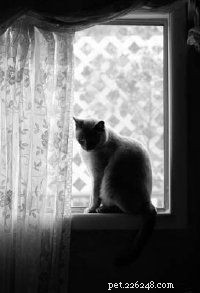
We all know to keep dangerous substances away from children, and it's important to remember that we should be even more careful with cats. We all know the old saying about what curiosity did to the cat. Because they are smaller, more mobile, and have more sensitive noses than children, cats are more likely to investigate, getting into things that can be dangerous. To prevent your cat's curiosity from becoming fatal, there are a few household dangers to look out for.
Drapery, blind, and electrical cords. To your cat's eye, the dangling end of a drapery or blind cord is an open invitation to play -- and possibly to disaster. Even just crawling between drapes or blinds and the window (an all-time favorite feline pastime) can land Tabby in a tangle. Cats who get caught in the loops of pull-cords panic. At the very least, the blinds or drapery rod will come down with a crash. At worst, a cat can strangle, do fatal internal damage, or actually get so worked up that his heart gives out. For maximum safety, tie or wrap all window cords well out of feline reach.
Electrical and telephone cords pose something of a tangling threat but more often are dangerous on account of chewing. It might be the taste or texture of the plastic coating, but for some reason, a lot of cats can't resist nibbling. There's not much direct danger in chewing phone cords (except when you try to make a call on a line that's been put out of commission by your cat) since there's very little current running through them.
Electrical cords are another story altogether, of course. Wherever possible, run the cords under rugs and carpets or behind furniture that sits flush to the floor and wall. If a cord has to be run where a cat can reach it, buy some inexpensive plastic conduit, which is available at most hardware and building supply stores. For a larger investment, you can get flat strips of heavy-duty vinyl that not only protect the electrical cords, but also keep the cords flush to the floor to prevent tripping.
Occasionally, a very determined cat will make his way through all the physical barriers. Treating the cords with a bad-tasting substance like bitter apple might do the trick. A little behavior modification, using positive reinforcement, will help, too.
Cleaning fluids, antifreeze, and other poisons. We don't just buy cleaners to get our house clean; we want it disinfected and smelling nice, too. Unfortunately, some of the very products we buy to sanitize and deodorize pet areas are outright dangerous for your cat.
Pine-based cleaners and those containing phenol (the most popular being Lysol disinfectant) are particularly toxic to cats and shouldn't be used on food bowls or in pet areas, sleeping quarters, or litter boxes. Of course, any cleaning compound can be poisonous if taken internally, so keep everything secured in a locking cabinet. (A simple spring latch won't keep a determinedly curious cat out.)
Ethylene glycol is the stuff that makes antifreeze work. It just so happens that it also smells and tastes very sweet. A significant number of cats and dogs -- and even small children -- suffer from ethylene glycol poisoning every winter. Because it's present in large amounts in almost every home and is often very fatal if swallowed, antifreeze and other products containing ethylene glycol should be considered dangerous and never left where pets or children can get to them.
Cats who go outdoors run the added risk of lapping up antifreeze spills and drips, an especially tempting thing for a thirsty cat to do since those puddles of tasty liquid don't freeze on cold days. You can protect your own cat (and other outdoor cats and strays) by immediately cleaning up and washing down any of your own spills or drips, or you can purchase one of the new nontoxic brands of antifreeze that contain propylene glycol rather than ethylene glycol. It's important to also keep in mind that once your cat leaves your property, there's no guarantee that everyone else in the area is going to be equally careful.
In general, anything that's toxic to you will be poisonous to your cat as well. The rule of thumb is:If you'd keep it out of reach of a child, keep it out of reach of your cat.
Poisonous plants. A cat chewing on your houseplants is more than an annoyance, it can be dangerous or even fatal to the cat.
Technically, any plant that makes your cat sick when eaten is a "poisonous" plant. (Nearly all cats will eat grass or plants to purge themselves, however, so vomiting alone may not be a reliable sign of poisoning.) Still, some plants have particularly serious effects. The list of potentially poisonous plants includes:apricot (pits), azalea, buttercup, caladium, calla lily, castorbean, cherry (twigs, leaves, bark, fruit, and stones), chrysanthemums, crocus, daffodil (bulbs), daphne (berries), holly, hydrangea, iris (leaves, roots, and fleshy parts), ivy, lily of the valley (leaves, flowers, roots), mistletoe (especially the berries), mushrooms, narcissus (bulbs), oak (acorns, young shoots, and leaves), oleander, peach (pits), philodendron, poison ivy, potatoes ("eyes" and sprouts from the eyes; the edible part of the potato is safe), privet, rhubarb (leaves), rosary pea (shiny red and black seeds), star of Bethlehem (bulb), string-of-pearls, sumac, and sweet pea (seeds and pods).
Dieffenbachia is a fairly common houseplant that also goes by the name of "dumb cane." The dumb cane is aptly named. Chewing dieffenbachia can actually paralyze your cat's mouth, making it impossible for him to eat and drink. The name "dumb cane" comes from the most noticeable effect of this paralysis on people:They can't talk.
Poinsettias (Christmas flowers) belong to the nightshade family -- flowers notorious in fact and literature for their deadly properties. A study a few years back seemed to show that poinsettias -- long believed to be dangerously toxic to cats and dogs -- don't make cats any sicker than many plants considered nonpoisonous. Still, it's always safest to keep cats away from any houseplant, just to be sure.
Windows, balconies, and screens. "High-rise syndrome" might sound like some sort of pop psychology explanation for violent crime, but it actually describes an epidemic that hits a number of cats every year, especially in warmer weather. "High-rise syndrome" is a collection of various injuries that are the result of a fall from a high window.
Amazingly, there are many stories of cats surviving falls from several flights up. But there are far more who fell and didn't make it. The saddest part of it is nearly all of those falls could have been prevented.
Every window that you plan to open needs to have a screen. And not just any screen. A cat-proof screen has to fit the window frame securely enough to stay firmly in place when confronted by ten or more pounds of cat. When ordering or replacing screens, use a heavy-duty grade of hardware cloth since ordinary screens can be easily torn by claws or teeth. Even a fall from a second- or third-story window can cause serious injury or death, so inspect all screens regularly, especially toward the end of winter in cold-weather areas of the country. Screens can warp, tear, or fatigue in the off-season.
Some city cat owners think letting Tabby out on the balcony of their apartment is a safe way to give him some fresh air and sunshine. Actually, a good number of "high-rise syndrome" cats were stalking moths, birds, or other irresistible things on an upper-floor balcony, when an ill-timed pounce or missed step sent them over the railing. Even a leash or tether on an open balcony doesn't ensure your cat's safety. A panicked cat dangling by his collar or harness can be strangled, seriously injured, or squirm loose and fall anyway.
Though you buy toys to amuse your cat, the wrong toy can be dangerous. In the next section, we will teach you what toys are safe for your cat.
The Animal Poison Control Hotline
"My cat is a chowhound -- she never misses a meal," one cat owner recalls. "So when she didn't come running at dinnertime, I knew something was very wrong. I found her under the bed, and when I coaxed her out, she was staggering and drooling. I was terrified. She had this funny smell, which I recognized as the cleaning fluid I kept in my linen closet. I ran to the closet, and I found the door open and the can of cleaning fluid spilled on the floor.
"The problem is, we live a good 30 minutes from the nearest veterinarian. I didn't know how long she had been poisoned, and I wasn't sure that she had another half hour to spare. Then I remembered about the hotline -- and it saved my cat's life."
The ASPCA National Animal Poison Control Center (also called the Animal Poison Hotline) is operated by the University of Illinois College of Veterinary Medicine. Call 1 (888) 426-4435. There's a $55 flat fee, chargeable to a credit card (have your charge card ready). For more information, contact ASPCA Animal Poison Control Center (1717 South Philo Rd., Suite 36, Urbana, Illinois 61802).
consulte Mais informação
Cat Toys
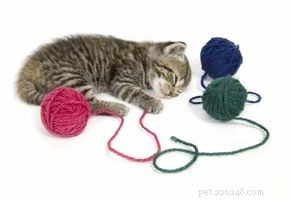
It's like something right out of a Norman Rockwell painting:a fuzzy little kitten tumbling around with a ball of yarn. Well, old Norman apparently never had to rush his cat to the vet for emergency surgery to get a couple of feet of that yarn unraveled from the poor cat's digestive tract. Yarn and string can turn even the most disinterested cats wide-eyed and playful but should never be left where cats or kittens can get at it on their own. Besides choking and intestinal blockage dangers, a cat who gets tangled up in string or yarn -- even during supervised play -- can panic and injure himself, possibly fatally. Take special care to keep sewing thread and dental floss out of feline reach; it's much finer and can become imbedded in the tissues of your cat's mouth, stomach, and intestines.
Cats will turn anything shiny, crinkly, or small enough to bat across the floor into a toy. Since Tabby doesn't have hands, he has to pick up these makeshift toys in his mouth, where they can be easily swallowed (or if not easily swallowed, can cause choking). At best, a foreign object in your cat's digestive system can trigger vomiting or diarrhea, but it can often be much worse. Keep things like paper clips, foil, and rubber bands safely tucked away.
Cellophane candy wrappers are particularly dangerous. Cats can't resist the crinkly texture, and the sugary residue makes them a cinch to get eaten. The wrappers can liquefy in your cat's stomach, coating the lining and blocking the uptake of nutrients from food.
What makes for a safe cat toy? Here's what to look for:
Something sturdy. If it can get tossed, thrown, gnawed, clawed, batted, kicked, licked, and repeatedly pounced on without coming apart, it's a good cat toy. Catnip-filled toys encourage play, but most cats like to eat catnip and will try to lick and chew their way to that scrumptious herbal filling. Catnip toys made from light fabric or felt will most likely be in shreds--and the shreds in your cat's tummy -- within a week. Ditto for plastic or vinyl toys that can be chewed up, cracked, or shattered.
No (re)movable parts. Catnip mice with yarn tails; crinkly cater- pillars with bug eyes; oversized plush "bumblebees" with glued-on felt features, and plastic mesh balls with tantalizing little bells inside are four of the more popular cat toys. But they share a common failing:small and potentially dangerous parts that come off. If you can pull or peel a part or decoration off a cat toy, the odds are your cat can, too. In fact, go ahead and try it with all your cat's toys -- it's better to have some catnip mice without tails than make a trip to the vet to get the tails out of your cat's stomach.
Something fun. A toy just isn't a toy if your cat won't play with it. Cat owners are often disappointed--and frequently annoyed -- to find that the $100 worth of custom cat toys they bring home get passed over for a piece of crumpled paper or a simple table tennis ball. Cats like games that involve what they do best:climbing, running, leaping, stalking, and pouncing. Pick toys that encourage those behaviors, and your cat is bound to use them. That's the allure of the table tennis ball -- it rolls and hops and skitters away when your cat pounces on it, encouraging batting and chasing. Cats see moving edges better than stationary objects, so toys that wiggle, bob, or weave fascinate them and trigger the stalking and hunting reflexes.
In our final section, we will cover perhaps the most important part of caring for you pet -- finding a good veterinarian. Finding a good vet for your cat is just as important as finding a good doctor for yourself.
Veterinarian Visits and Vaccinations

Choosing a veterinarian for your cat is a lot like choosing a doctor for yourself. You want someone with a good bedside manner and someone you like and trust. If you have special needs, you also want a doctor who understands and keeps those needs in mind.
Finding a Vet
If you're a first-time cat owner, have recently moved to a new area, or need to find a new veterinarian, you can just try opening the Yellow Pages to "Animal Hospitals." All veterinarians go to school as many years as medical doctors and have to meet strict standards for licensing, so you're bound to find a competent and professional vet that way. But the relationship among you, your pet, and your vet is going to last for many years, and if you took the time to find just the right cat, it makes sense to find the right vet. This might be the one area where city folk have it over country folk. A small town may just have one vet, while a big city has dozens within several miles.
Besides the Yellow Pages, here are some other sources for finding a good veterinarian:
Contact professional organizations. The American Veterinary Medical Association (www.avma.org) can refer you to affiliated veterinarians in your area, and the American Animal Hospital Association (www.aahanet.org) can direct you to clinics that meet its standards. The AVMA can also help you find feline specialists, behavior experts, veterinary eye doctors, and other professionals. Like any specialist, though, expect to pay heftier fees.
Get recommendations from other "cat people." Friends, family, and neighbors who have cats usually also have veterinarians. Take advantage of their experience, and get recommendations from them.
Look Before You Leap
Once you get a referral for a veterinarian, call up, introduce yourself, and find out when you can drop by to see the facilities and meet the doctors. Make your visit brief but thorough. Be discriminating, but don't be put off if the vet and the clinic staff can't spend a long time with you -- they do have a hospital to run and patients to take care of. If you have a lot of questions and need the vet's undivided attention, the most polite thing to do is make an appointment -- and offer to pay for it.
If you are going to drop by the facility and meet with the vet, here are some items to consider:
Feline Vaccinations What exactly are vaccinations, and how do they help keep cats healthy? Here's how most vaccines work. Researchers find the germ causing the disease--for example, the virus that causes feline distemper. Next they produce a harmless, noncontagious version of the virus. This form of the virus is used to vaccinate healthy cats. The vaccine triggers the cat's disease-fighting immune system, which attacks and destroys the virus. This exposure "primes" the immune system so that if the same virus shows up again -- even the dangerous, contagious version -- it will be destroyed before it can cause illness.Vaccines protect your cat from common diseases, mostly caused by viruses. When a virus invades an animal's body, no medicine can kill it. You can give a cat with a virus things like antibiotics from now until doomsday, and it won't cure the disease (although the antibiotics will help treat or control infections that might start as a result of the cat's being sick with the virus). Viral diseases just have to run their course, after which the victim is often immune for life. Vaccines (usually with regular booster shots) provide your cat with the benefits of being immune without actually having to suffer through the disease.
Vaccines can't cure diseases caused by viruses. Going back to feline distemper for a moment, if a cat has already contracted this disease, the vaccine won't stop it. Vaccines also can't prevent every viral disease every time. No vaccine is 100 percent effective, so every once in awhile a cat who has all his shots will still get sick with something he's supposed to be protected against. Some diseases, like FIV, are caused by viruses that shut down the immune system when they first enter the cat's body. In those cases, the vaccine can't do its job because its tools (the disease-fighting system of the cat's body) have been taken away.
Get your cat's shots from a veterinarian or animal hospital. At the bare minimum, cats should be up-to-date on their rabies shot and distemper-combination vaccine. The combination shot usually carries protection against feline distemper (panleukopenia) and common upper respiratory diseases that cause cold- or flu-like symptoms in your cat (feline viral rhinotracheitis, calicivirus, and chlamydia). Vaccines may be given as an injection under the skin or in the muscle or as an aerosol administered directly into the cat's nostrils.
Any cat being vaccinated for the first time usually needs a series of shots, spaced several weeks apart. For kittens, these shots start at seven or eight weeks of age and continue until they are four months old. Rabies vaccines are given as one shot administered initially to a kitten over three months of age and to adults of any age. The American Association of Feline Practitioners recommends that subsequent boosters for many diseases (depending on the type of vaccine used) be given a year from the initial series and then every three years thereafter. Check with your veterinarian for vaccine scheduling recommendations for your cat.
Vaccines for other cat diseases have been around since the mid-1980s, particularly the one for feline leukemia virus (FeLV). FeLV (or FeLeuk, as it's sometimes known) attacks a cat's white blood cells and can produce a kind of cancer. Research shows that most cats exposed to FeLV don't get sick, but even infected cats who appear healthy can still pass the virus on to other cats. Once a cat does get sick from FeLV, though, the odds of recovery are poor.
The FeLV is a funny creature -- it doesn't last long outside of a cat's body, unless it stays a little moist. So the most common way FeLV gets passed is prolonged close contact between a healthy cat and infected cat -- things like mutual grooming, or sharing food, water, or litter boxes. This also means that the FeLV vaccine may not be necessary for a cat that is never exposed to FeLV-infected cats. A simple blood test can determine if your cat (or any new cat you're thinking of taking into your home) is infected. If not, keeping your FeLV-free cats indoors and away from FeLV-infected cats is probably all the protection they need (outdoor or indoor/outdoor cats are a different story). If your cat tests positive for FeLV, the vaccine won't help, either; vaccines don't kill the virus, they only protect uninfected cats from getting it.
Feline immunodeficiency virus (FIV) and feline infectious peritonitis (FIP) are also fatal cat diseases caused by viruses. There are laboratory tests for their detection, but the test used currently for FIP can give inconclusive results. Vaccines exist for FIV and FIP, but the jury is still out on their effectiveness in preventing disease transmission. Your veterinarian can help you figure out if your cat is at risk for these diseases and if the potential benefits of each vaccine outweigh the risks.
While you will face many challenges as a pet owner, you now know the basic care tips that every cat needs to be happy and healthy.
Publications International, Ltd.

